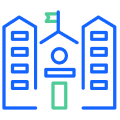More for less: How schools can maximize their technology investments
Technology isn’t a cure-all for our education system. Teachers will always be the most important component. Still, when properly selected and used effectively, technology can improve student achievement.
The problem is when a district doesn’t have enough of a technology budget to serve their vast needs. Fortunately, schools can employ a number of strategies and tactics to maximize their investments:
Include professional development around technology
According to The Mirage, an extensive report about teacher development by The New Teacher Project: “Teachers need clear information about their strengths and weaknesses to improve their instruction, but many don’t seem to be getting that information.”
This may be because much of today’s professional development doesn’t go far enough. According to the report, 60% of teachers reported that professional development was not a good use of their time.
The bleak news certainly isn’t due to lack of commitment. As the report says, “The districts we studied spend an average of nearly $18,000 per teacher, per year —the equivalent of 6 to 9 percent of their annual operating budgets. Based on those estimates, we project that the 50 largest school districts in the U.S. likely spend a combined $8 billion every year on teacher development.”
Part of the problem is that professional development has become a required, check-off-the-boxes exercise. Schools must offer training that includes differentiated instruction for using technology in the classroom. Invest in people, not just the tools.
“District leaders agree that teaching should be differentiated based on a student’s strengths and weaknesses,” says my colleague Mark Munro, a former teacher. “Teacher professional development should follow in the same vein. Give teachers the latitude to achieve their own goals with the digital tools provided by the district.”
Change your purchasing process
Schools often choose either what’s trendy or what the vendor tells them to buy. In turn, they can spend more than necessary, whether it’s software that never gets used or software people are unable to use.
Put together a technology plan that’s realistic, based on what you can accomplish. It’s not a matter of saying, “We need 10,000 laptops.” First discover what teachers want, what they’ll use, what fits with the culture of learning in your district. Also consider the nature and scope of the training. How will the hundreds of teachers in the district learn how to use (fill in the blank) technology? Put it in the plan.
Getting teachers involved requires more than large group professional development. Visit the classroom to better understand the environment. Create a forum for teachers to communicate with each other, such as a Slack channel or something similar. They need to have a constant discussion about what issues they’re facing, which ultimately creates a unified voice regarding learning software choices.
Also meet with colleagues from other districts to learn how they made certain decisions. How did they handle issues like price, network bandwidth, and amount of support? What was their experience with a specific vendor? How did they handle negotiations?
Try free tools
Technology doesn’t have to be expensive, take forever to purchase or be difficult to use. There is a growing amount of free tools that improve teaching and learning including:
- Gubric makes it easy for teachers to assess digital documents
- Doctopus allows teachers to manage student projects
- Google Docs, by now an oldie but goodie, can be overlooked. It’s great for fostering collaboration and grading work faster.
Help great teachers be even greater
Across the country teachers are working hard to educate their students. They’re open to new concepts for closing the achievement gap, but as humans they can only do so much research.
A few ideas:
- Try giving students positions of leadership, specifically when it comes to technology. Most likely, they’ll have more advanced skills than some teachers, which goes a long way in helping less knowledgeable students and allowing for more teaching time. Students interact more in class, a healthy habit to develop for anyone on the K-12 spectrum.
- Another proven idea gaining traction is independent practice. In this type of learning, students get a chance to better hone their skills and knowledge before a test.
While these teaching methods don’t necessarily save money, they do improve student learning without adding costs. And for districts on tight budgets, that’s about as good as it gets.

More to read

January 22, 2024
Implementing school security tools with a team of oneClever IDM revolutionizes school security by simplifying password management, reducing IT support tickets, and streamlining operations. This partnership empowers a K-12 leader in Wisconsin to efficiently implement changes, boost security, and confidently embrace broader technology initiatives.

January 12, 2024
K-12 Administrator guide to evaluating edtech vendor securityDiscover key steps to select edtech vendors with a cybersecurity focus, bolstering your school's protection of student data.

November 29, 2023
Layered security and LMS interoperability advancements announced at Clever CIO eventProduct updates to Clever to support K-12 education technology leaders in planning, budgeting, and making decisions about educational technology.

















